Jan 27th, 2025
A. Brinkerhoff et al.
Successful operation of large particle detectors like the Compact Muon Solenoid (CMS) at the CERN Large Hadron Collider requires rapid, in-depth assessment of data quality. We introduce the “AutoDQM'” system for Automated Data Quality Monitoring using advanced statistical techniques and unsupervised machine learning. Anomaly detection algorithms based on the beta-binomial probability function, principal component analysis, and neural network autoencoder image evaluation are tested on the full set of proton-proton collision data collected by CMS in 2022. AutoDQM identifies anomalous “bad” data affected by significant detector malfunction at a rate 4--6 times higher than “good” data, demonstrating its effectiveness as a general data quality monitoring tool.
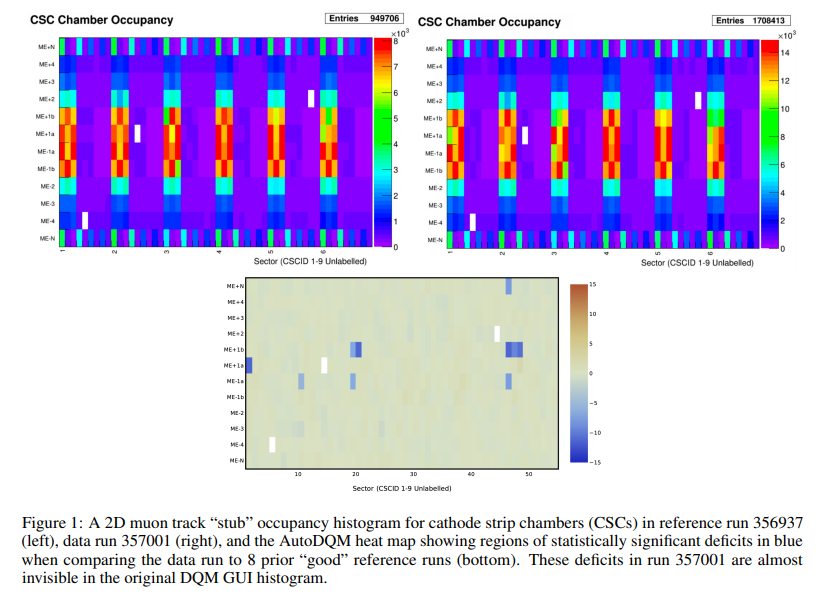
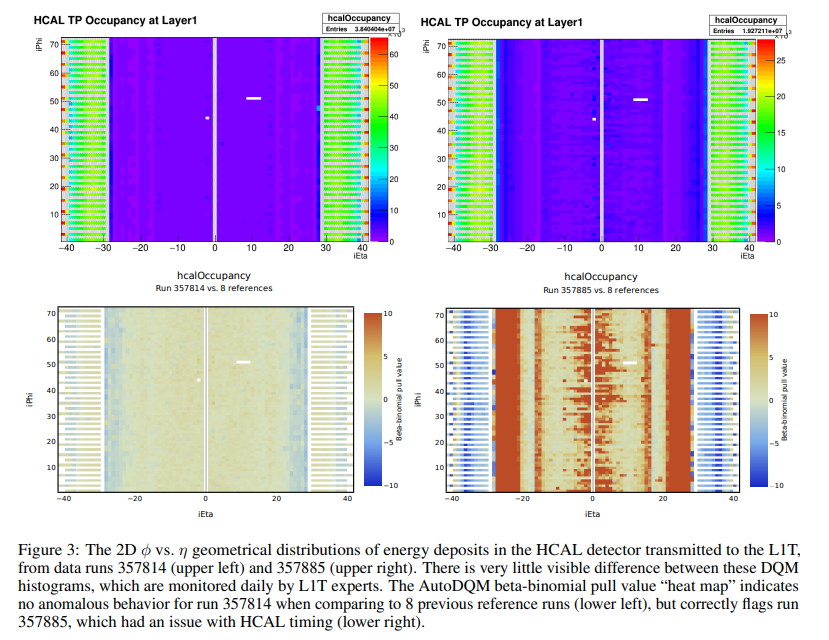
LHCb Collab.
The Upsilon(2S) and Upsilon(3S) production cross-sections are measured relative to that of the Upsilon(1S) meson, as a function of charged-particle multiplicity in proton-proton collisions at a centre-of-mass energy of 13 TeV. The measurement uses data collected by the LHCb experiment in 2018 corresponding to an integrated luminosity of 2fb-1. Both the Upsilon(2S)-to-Upsilon(1S) and Upsilon(3S)-to-Upsilon(1S) cross-section ratios are found to decrease significantly as a function of event multiplicity, with the Upsilon(3S)-to-Upsilon(1S) ratio showing a steeper decline towards high multiplicity. This hierarchy is qualitatively consistent with the comover model predictions, indicating that final-state interactions play an important role in bottomonia production in high-multiplicity events.
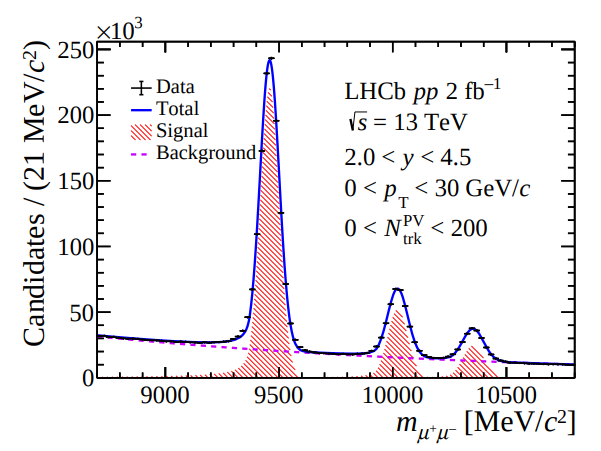
ATLAS Collab.
In 2022 and 2023, the Large Hadron Collider produced approximately two billion hadronic interactions each second from bunches of protons that collide at a rate of 40 MHz. The ATLAS trigger system is used to reduce this rate to a few kHz for recording. Selections based on hadronic jets, their energy, and event topology reduce the rate to O(10) kHz while maintaining high efficiencies for important signatures resulting in b-quarks, but to reach the desired recording rate of hundreds of Hz, additional real-time selections based on the identification of jets containing b-hadrons (b-jets) are employed to achieve low thresholds on the jet transverse momentum at the High-Level Trigger. The configuration, commissioning, and performance of the real-time ATLAS b-jet identification algorithms for the early LHC Run 3 collision data are presented. These recent developments provide substantial gains in signal efficiency for critical signatures; for the Standard Model production of Higgs boson pairs, a 50% improvement in selection efficiency is observed in final states with four b-quarks or two b-quarks and two hadronically decaying τ-leptons.
R. Amarinei
Mu3e is an experiment currently under construction at the Paul Scherrer Institute in Switzerland, designed to search for the Lepton Flavor Violating (LFV) decay μ+→e+e−e+. In extensions of the Standard Model (SM) that account for neutrino masses, this decay is theoretically allowed but occurs only through extremely rare loop processes, with a predicted branching ratio of approximately O(10−54). Such a small probability implies that any observation of this decay would provide clear evidence for physics beyond the SM.
The Mu3e experiment aims to probe the μ+→e+e−e+ decay with a sensitivity of approximately O(10−15) in its Phase-1 and plans to achieve a sensitivity of O(10−16) after future upgrades. To reach its Phase-1 ambitious goals, Mu3e is going to use the most intense continuous muon beam in the world, generating 108 muon stops per second in the target placed at the center of the Mu3e.
Mu3e will use three main technologies for particle detection. The tracking will done through ultra-thin (50 - 70 μm) pixel detectors based on MuPix11 sensors. These are high-voltage monolithic active pixel sensors (HV-MAPS) with a ∼ 23 μm spatial resolution. The timing will be done through scintillating fibres (∼ 250 ps) and tiles (∼ 40 ps), coupled to silicon photomultipliers and read out by MuTRiG3 ASICs. A triggerless DAQ system based on FPGAs will collect data from the detectors, which will then undergo reconstruction in a GPU filter farm. The assembly of the detectors has started, with a detector commissioning beam time planned for 2025. This document reports on the status of the construction, installation, and data-taking plans for the near future.
Akitaka Ariga, Jamie Boyd, Felix Kling, Albert De Roeck
The proton-proton collisions at the Large Hadron Collider (LHC) produce an intense, high-energy beam of neutrinos of all flavors, collimated in the forward direction. Recently two dedicated neutrino experiments, FASER and SND@LHC, have started operating to take advantage of the TeV energy LHC neutrino beam, with first results released in 2023 and further results released in 2024. The first detection of neutrinos produced at a particle collider opens up a new avenue of research, allowing to study the highest energy neutrinos produced in a controlled laboratory environment, with an associated broad and rich physics program. Neutrino measurements at the LHC will provide important contributions to QCD, neutrino and BSM physics, with impactful implications for astro-particle physics. This review article summarizes the physics motivation, status and plans of, present and future neutrino experiments at the LHC.
Ayan Chattaraj, Anirban Majumdar, Rahul Srivastava arXiv:2501.12441
We explore the potential of reactor neutrino-induced Coherent Elastic Neutrino-Nucleus Scattering (CEνNS) data from the CONUS+ experiment to investigate both Standard Model (SM) and Beyond Standard Model (BSM) scenarios. Alongside CEνNS, elastic neutrino-electron scattering (EνES) events are also included in our analysis, enabling more stringent constraints on new physics. Within the SM, we examine the weak mixing angle as a precision test of the electroweak sector. For BSM scenarios, we constrain the parameter space of light mediators arising from neutrino generalized interactions (NGI), while also setting limits on the electromagnetic properties of neutrinos, including their charge radius, millicharge, and magnetic moment.
Ayan Chattaraj, Anirban Majumdar, Dimitrios K. Papoulias, Rahul Srivastava arXiv:2501.12443
We explore the potential of the European Spallation Source (ESS) in probing physics within and beyond the Standard Model (SM), based on future measurements of coherent elastic neutrino-nucleus scattering (CEνNS). We consider two SM physics cases, namely the weak mixing angle and the nuclear radius. Regarding physics beyond the SM, we focus on neutrino generalized interactions (NGIs) and on various aspects of sterile neutrino and sterile neutral lepton phenomenology. For this, we explore the violation of lepton unitarity, active-sterile oscillations as well as interesting upscattering channels such as the sterile dipole portal and the production of sterile neutral leptons via NGIs. The projected ESS sensitivities are estimated by performing a statistical analysis considering the various CEνNS detectors and expected backgrounds. We find that the enhanced statistics achievable in view of the highly intense ESS neutrino beam, will offer a drastic improvement in the current constraints obtained from existing CEνNS measurements. Finally, we discuss how the ESS has the potential to provide the leading CEνNS-based constraints, complementing also further experimental probes and astrophysical observations.
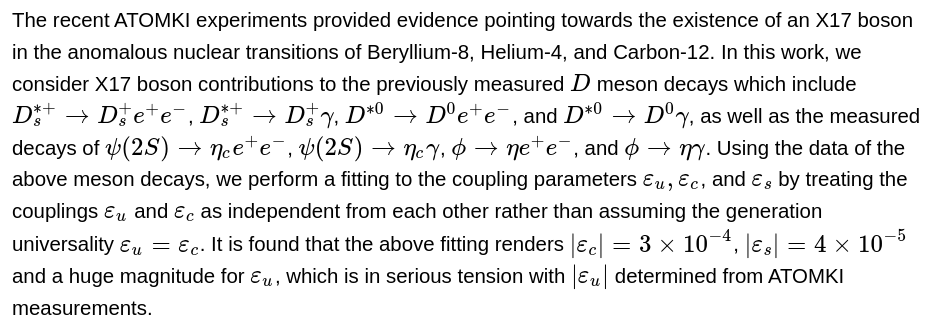
https://en.wikipedia.org/wiki/X17_particle
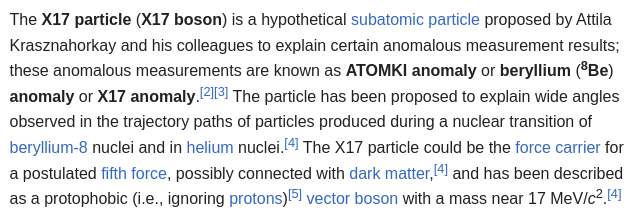
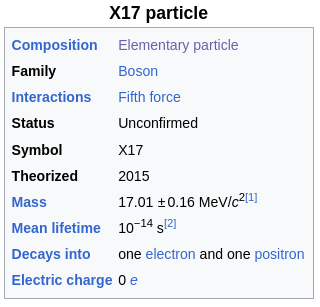
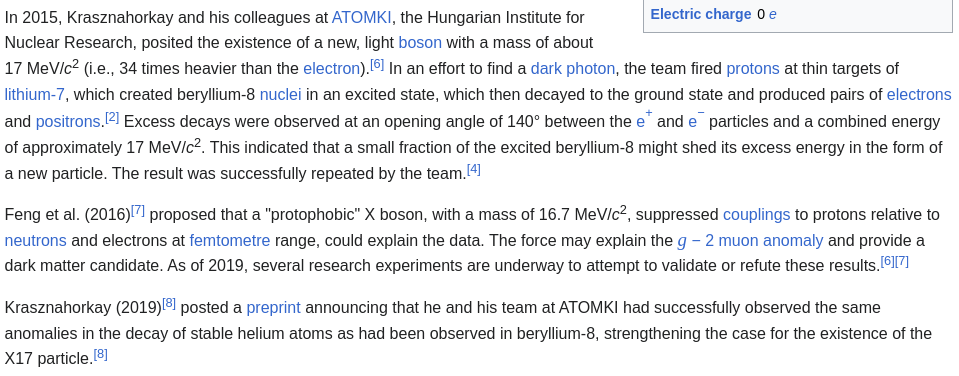
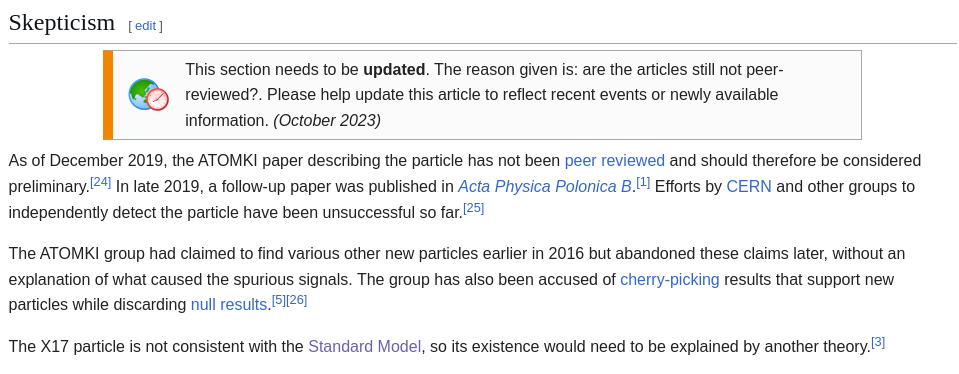
A. Aleksejevs, S. Barkanova, Yu.G. Kolomensky, B. Sheff
